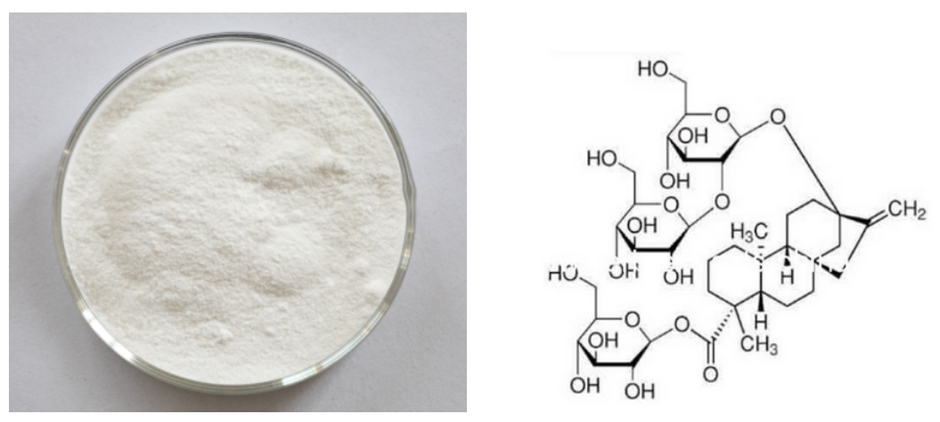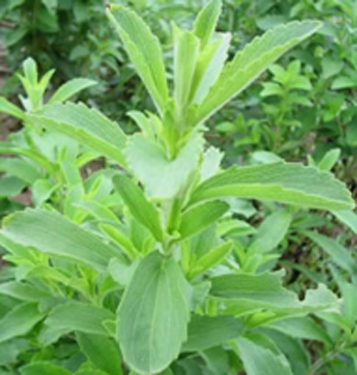Online Manufacturer for Stevia Extract Factory in Bangladesh
Online Manufacturer for Stevia Extract Factory in Bangladesh Detail:
[Latin Name] Stevia rebaudiana
[Plant Source]from China
[Specifications] 1.Stevia Extract Powder (Steviosides)
Total Steviol Glycosides 80%, 90%, 95%
2. Rebaudioside-A
Rebaudioside-A 40%, 60%, 80%, 90%, 95%, 98%
3. Stevioside 90%
One monomer in Steviol Glycosides
[Appearance] Fine white powder
Plant Part Used:Leaf
[Particle size] 80 Mesh
[Loss on drying] ≤5.0%
[Heavy Metal] ≤10PPM
[Shelf life] 24 Months
[Package] Packed in paper-drums and two plastic-bags inside.
[Net weight] 25kgs/drum
Stevia Extract
[Characteristics]
Stevia sugar features high sweetness and low calorie and its sweetness is 200 350 times of that of cane sugar but its calorie is only 1/300 of that of cane sugar.
The component of stevia extract that gives it its sweetness is a mixture of various steviol glycosides. The components of sweetness in stevia leaves are stevioside, rebaudioside A, C, D, E and dulcoside A. Rebaudioside C, D, E and dulcoside A are small in quantity. The principal components are stevioside and rebaudioside A.
The quality of stevioside and rebaudiosideA is better than those of other components, which are commercially extracted and used in various applications.
The steviol glycosides present in stevia extract are referred to as “steviosides” or ¡°stevia extract¡±. Among these “steviosides”, the most common is Stevioside followed by RebaudiosideA. The Stevioside has a slight and pleasant herbal taste and the Rebaudioside-A has no herbal taste.
Although Rebaudioside C and dulcoside A are small in quantity in stevia extract, they are the major components giving bitter aftertaste.
[Function]
A large number of pharmaceutical tests have proved that stevia sugar has no side effects, carcinogens, and is safe for eating.
Compared with cane sugar, it can save 70% of the cost. With pure white color, pleasing taste and no peculiar smell, Stevia sugar is a new sugar source with broad perspective for development. Stevia rebaudianum sugar is the natural low hotsweet agent mostly similar to the flavor of cane sugar, approved to be used by State Ministry of Health and Ministry of Light Industry.
It is the third natural succedaneum of cane sugar and beet sugar with development and health care value, extracted from the leaves of the herbal vegetable of the composite family-stevia rebaudianum.
Product detail pictures:

Related Product Guide:
Well-run products, skilled income group, and better after-sales products and services; We have been also a unified massive family, all people stick with the business price "unification, dedication, tolerance" for Online Manufacturer for Stevia Extract Factory in Bangladesh , The product will supply to all over the world, such as: Suriname, Thailand, Houston, We aspire to meet the demands of our customers globally. Our range of products and services is continuously expanding to meet customers' requirements. We welcome new and old customers from all walks of life to contact us for future business relationships and achieving mutual success!
Maxman XI is the replacement for Maxman 100. The new Maxman is an enhanced version and has been associated with Penis enhancement, and better sexual performance.
For more info and how to buy, visit https://youtu.be/DTqw1PgH-jE
Homemade Vegan Doughnuts are my favorite. This homemade treat will make your next breakfast or brunch or even for dessert so much better. This is a great base recipe for any of your favorite flavors of baked doughnuts. I also used a natural food coloring of beet powder to make this lovely maroon color.
This recipe uses my recipe for Vegan Sprinkles. It is the perfect recipe for decorating cookies and cakes. If you want to learn more how to make Vegan Sprinkles, click here: https://bit.ly/VeganSprinkles
If you have recipe you would like to see me make, let me know in the comments below. Let me know of what you think of this recipe on via twitter or instagram (@vegetarianbaker & #thevegetarianbaker).
Vegan Doughnuts Printable Recipe: https://bit.ly/2rLfBq3
Subscribe, It’s Free: https://bit.ly/SubscribeToVegetarianBaker
Brands I Used:
Beet Powder: https://amzn.to/2sAGCR5
Doughnut Baking Tray: https://amzn.to/2rKJeaY
Coconut Sugar: https://amzn.to/2tXeuUE
Ingredients:
For The Doughnuts:
All Purpose Flour | 2 Cups
Coconut Sugar | 3/4 Cup
Baking Powder | 3/4 teaspoon
Baking Soda | 3/4 teaspoon
Sea Salt | 1/4 teaspoon
Unsweetened Applesauce | 1/4 Cup
Vanilla Extract | 2 teaspoons
Organic Apple Cider Vinegar | 2 teaspoons
Almond Milk | 1 Cup + 1/4 Cup
For The Icing:
Powdered Sugar | 1 Cup
Beet Powder | 1/2 teaspoon
Almond Milk | 1 Tablespoon
Vanilla Extract | 1 teaspoon
Sea Salt | 1/4 teaspoon
Vegan Sprinkles | For Garnish
My Links:
website: https://www.vegetarianbaker.com
Instagram: https://www.instagram/vegetarianbaker
Twitter: https://www.twitter.com/vegetarianbaker
Pinterest: https://www.pinterest.com/vegetarianbaker
Facebook: https://www.facebook.com/thevegetarianbaker
Tumblr: https://www.thevegetarianbaker.tumblr.com
Music Provided By: https://us.audionetwork.com
We have been looking for a professional and responsible supplier, and now we find it.







